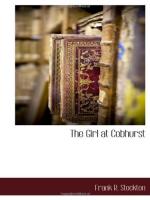Cobhurst was the name of an estate a mile or so from the Witton farm, whose wide fields had lain for a half a dozen years untilled, and whose fine old mansion had been, for nearly a year, uninhabited. Its former owner, Matthias Butterwood, a bachelor, and during the greater part of his life, a man who took great pride in his farm, his stock, and his fruit trees, had been afflicted in his later years with various kinds of rheumatism, and had been led to wander about to different climates and different kinds of hot springs for the sake of physical betterment.
When at home in these latter days, old Butterwood had been content to have his garden cultivated, for he could still hobble about and look at that, and had left his fields to take care of themselves, until he should be well enough to be his own farmer, as he had always been. But old age, coming to the aid of his other complaints, had carried him off a few months before this story begins.
The only person now living at Cobhurst was a colored man named Mike, who inhabited the gardener’s house and held the office of care-taker of the place.
Whenever Mike now came to town with his old wagon and horse, or when he was met on the road, he found people more and more inquisitive about the new owner of Cobhurst. Mike was not altogether a negro, having a good deal of Irish blood in his veins, and this conjunction of the two races in his individuality had had the effect upon his speech of destroying all tendency to negro dialect or Irish brogue, so that, in fact, he spoke like ordinary white people of his grade in life. The effect upon his character, however, had been somewhat different, and while the vivacity of the African and that of the Hibernian, in a degree, had neutralized each other, making him at times almost as phlegmatic as the traditional Dutchman, he would sometimes exhibit the peculiarities of a Sambo, and sometimes those of a Paddy.
Mike could give no satisfaction to his questioners; he knew nothing of the newcomer, except that he had received a postal card, directed to the man in charge of Cobhurst, and which stated that Mr. Haverley would arrive there on the fourth of April.
“More’n that,” Mike would say, “I don’t know nothin’. Whether he’s old or young, and what family he’s got, I can’t tell ye. All I know is, that he don’t seem in no hurry to see his place, an’ he must be a reg’lar city man, or he’d know that winter’s the time to come to work a farm in the spring of the year.”
Other people, however, knew more about Mr. Haverley than Mike did, and Miss Panney could have informed any one that he was a young man, unmarried, and a second nephew to old Butterwood. She had faith that Dr. Tolbridge could give her some additional points, provided she could get an opportunity of properly questioning him.
Meanwhile the days passed on; the roads about Thorbury dried up and grew better; in low, sheltered places, the grass showed a greenish hue; the willows turned yellow, and people began to ponder over the catalogues of seed merchants. At last, it was the third of April, and on that day, in a large bright room of a New York boarding-house, kneeling in front of an open trunk, were Mr. Ralph Haverley and his sister Miriam.




